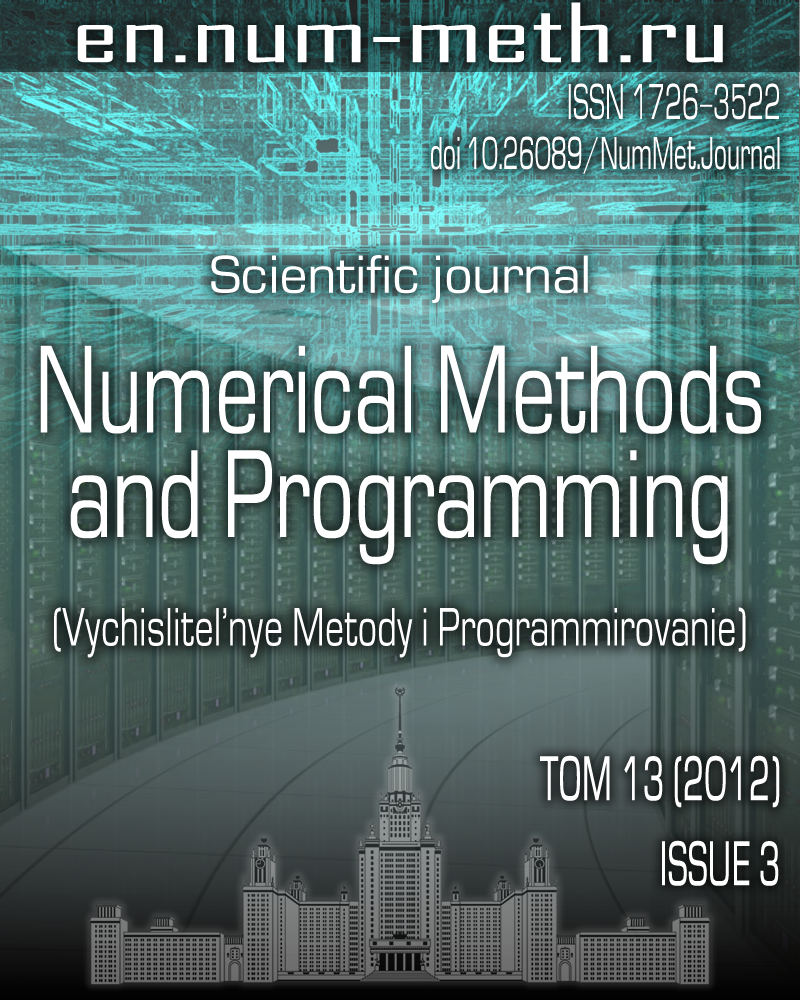Simulation of planet formation in circumstellar disks
Keywords:
self-gravitating circumstellar disk
particle-in-cell method
direct modeling method
formation of planetary embryos
Abstract
A numerical model of dynamics for a massive self-gravitating protoplanetary is proposed with consideration of inelastic pair collisions of particles. In the conducted computing experiments with ring structures in a disk, it is shown that the mass range change of particles occurs with the reproduction of the ring structure. It is found that the released thermal energy in bodies is maximal for bodies of small mass. This work was supported by the Integration project SB RAS (coordinator Acad. Mikhailenko B.G.) and the Presidium programs RAS NN 21, 22, 28.
Published
2012-10-01
Issue
Section
Section 1. Numerical methods and applications
References
- Сафронов В.С. Эволюция допланетарного облака и образование Земли и планет. М.: Наука, 1969.
- Boss A.P. Giant planet formation by gravitational instability // Science. 1997. 276, N 5320. 1836-1839.
- Boss A.P. Possible rapid gas giant planet formation in the solar nebula and other protoplanetary disks // The Astrophysical J. 2000. 536. 101-104.
- Cameron A.G. W. The first ten million years in the solar nebula // Meteoritics. 1995. 30. 133-161.
- Russell S.S., Srinivasan G., Huss G.R., Wasserburg G.J., MacPherson G.J. Evidence for widespread 26Al in the solar nebula and constraints for nebula time scales // Science. 1996. 273, N 5276. 757-762.
- Hartmann L. Accretion processes in star formation. Cambridge: Cambridge University Press, 1998.
- Hartmann L., Calvet N., Gullbring E., d’Alessio P. Accretion and the evolution of Tauri disks // The Astrophysical J. 1998. 495. 385-401.
- Lada C.J. The formation of low mass stars: an observational overview // The Origin of Stars and Planetary Systems. Ed. by C.J. Lada and N.D. Kylafis. Dordrecht: Kluwer Academic Publishers, 1999. 143-191.
- Beckwith S.V. W. Circumstellar disks // The Origin of Stars and Planetary Systems. Ed. by Ch.J. Lada and N.D. Kylafis. Dordrecht: Kluwer Academic Publishers, 1999. 579-612.
- Weidenschilling S.J. Dust to planetesimals - settling and coagulation in the solar nebula // Icarus. 1980. 44. 172-189.
- Weidenschilling S.J., Cuzzi J.N. Formation of planetesimals in the solar nebula // Protostars and Planets III. Tucson: Univ. of Arizona Press, 1993. 1031-1060.
- Pollack J.B. Origin and history of the outer planets: theoretical models and observations L contraints // Annual Review of Astronomy and Astrophysics. 1984. 22. 389-424.
- Lissauer J.J., Pollack J.B., Wetherill G.W., Stevenson D.J. Formation of the Neptune system // Neptune and Triton. Tucson: Univ. of Arizona Press, 1996. 37-108.
- Pollack J.B., Hubickyj O., Bodenheimer P., Lissauer J.J, Podolack M., Greenzweig Y. Formation of the giant planets by concurrent accretion of solids and gas // Icarus. 1996. 124. 62-85.
- Weidenschilling S.J., Spaute D., Davis D.R., Marzari F., Ohtsuki K. Accretional evolution of a planetesimal swarm // Icarus. 1997. 128. 429-455.
- Levison H.F., Lissauer J.J., Duncan M.J. Modeling the diversity of outer planetary systems // The Astronomical J. 1998. 116, N 4. 1998-2014.
- Weidenschilling S.J., Marzari F. Gravitational scattering as a possible origin for giant planets at small stellar distances // Nature. 1996. 384. 619-621.
- Lin D.N. C., Ida S. On the origin of massive eccentric planets // Astrophysical J. 1997. 477. 781-791.
- Ford E.B., Rasio F.A., Sills A. Structure and evolution of nearby stars with planets. I. Short-period systems // The Astrophysical J. 1999. 514, N 1. 411-429.
- Kley W. On the migration of a system of protoplanets // Monthly Notices of the Royal Astronomical Society. 2000. 313, N 4. L47-L51.
- Дорофеева В.А., Макалкин А.Б. Эволюция ранней Солнечной системы. Космохимические и физические аспекты. М.: Едиториал, 2004.
- Энеев Т.М., Козлов Н.Н. Модель аккумуляционного процесса формирования планетных систем // Астроном. вестн. 1981. XV, № 2. 80-94.
- Снытников В.Н., Пармон В.Н., Вшивков В.А., Дудникова Г.И., Никитин С.А., Снытников А.В. Численное моделирование гравитационных систем многих тел с газом // Вычислительные технологии. 2002. 7, № 3. 72-84.
- Smoluchowski M. Drei Vortrage uber Diffusion, Brounische Bewegung und Koagulation von Kolloidteilchen // Phys. Zeits. 1916. 17. 557-595.
- Галкин В.А. Уравнение Смолуховского. М.: Физматлит, 2001.
- Белоцерковский О.М., Давыдов Ю.М. Метод крупных частиц в газовой динамике. М.: Наука, 1982.

